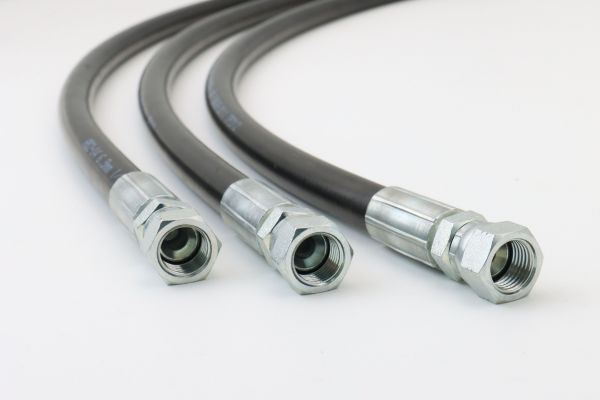The failure of these components can lead to dire consequences. Not only do hose assembly failures pose significant safety risks, including potential injury to personnel, but they also contribute to operational downtime and substantial financial losses due to repairs, replacements, and halted production. Recognizing these risks, this post aims to arm industry professionals and enthusiasts with critical knowledge and actionable tips. By adhering to these guidelines, you can ensure the reliability, efficiency, and longevity of your high-pressure hose assemblies, mitigating risks and maintaining seamless operations.
The selection of the right hose is a critical decision in the design and maintenance of high-pressure hydraulic systems. This choice goes beyond merely picking a hose off the shelf; it involves a detailed consideration of the application’s specific needs. Factors such as pressure ratings, temperature range, fluid compatibility, and environmental conditions play a pivotal role in determining the most suitable hose material and design. The right hose ensures optimal performance, longevity, and safety, significantly reducing the risk of failure under high-pressure operations.
Selecting a hose with the appropriate pressure rating is paramount. A hose’s pressure rating must match or exceed the maximum operating pressure of the hydraulic system, including any potential pressure spikes. Underestimating the system’s pressure can lead to hose bursts, whereas overestimation can unnecessarily increase costs and reduce flexibility.
The operating temperature range of the system is another critical factor. Both the fluid temperature and the ambient temperature can affect hose performance. Materials that are not suited to the temperature range can degrade, leading to leaks, cracks, and ultimately, system failure.

Incompatible materials can degrade when exposed to certain fluids, causing the hose to swell, delaminate, or even disintegrate, which can lead to contamination of the system and environment, as well as system failure.
Environmental factors such as exposure to UV light, ozone, chemicals, saltwater, and extreme temperatures can affect hose materials. For example, rubber hoses can degrade when exposed to UV light or ozone, while metal hoses can corrode in salty or acidic environments.
Proper installation of high-pressure hose assemblies is vital to their performance and longevity. Incorrect installation can lead to premature hose failure, resulting in leaks, bursts, and potentially severe safety hazards.
Twisting a hose can significantly weaken its structure, leading to reduced life expectancy and increased risk of failure under pressure. During installation, ensure that the hose is aligned correctly, with the fittings oriented to prevent any torsion. Kinking, on the other hand, occurs when a hose is bent too sharply, causing a constriction that can impede fluid flow and increase internal pressure. To avoid kinking, always adhere to the minimum bend radius specified by the manufacturer.
The bend radius of a hose is the minimum radius one can bend the hose without damaging it or significantly reducing its life. It is a critical factor to consider during installation. Exceeding the recommended bend radius can cause the hose’s layers to separate or the reinforcement to weaken, leading to a failure. Ensure that the hose’s routing allows for gentle curves rather than sharp bends, respecting the manufacturer’s recommended bend radius at all times.
Accounting for system movement and expansion is essential when determining the correct length of a hose. Thermal expansion and contraction, as well as mechanical movement, can all affect hose length. A hose that is too short may become stretched or compressed, leading to stress at the fittings and potential failure. Conversely, a hose that is too long can lead to looping or sagging, which can cause abrasion or kinking. To accommodate movement and expansion, provide a slight excess in length and consider the routing paths that allow the hose to flex without stretching or compressing.
A proactive approach to the inspection and maintenance of high-pressure hose assemblies is essential for ensuring their reliability and longevity. Regularly scheduled inspections can identify potential issues before they lead to failure, while maintenance practices, including timely replacement, can prevent downtime and ensure the safety of operations. Here’s how to establish an effective routine inspection plan and understand the importance of maintenance and replacement protocols.
Frequency: Determine the inspection frequency based on the hose application, environment, and historical performance. High-risk applications may require more frequent inspections, such as daily or weekly, while lower-risk environments might necessitate monthly or quarterly checks.
Inspection Checklist: Develop a comprehensive checklist that includes examining hoses for signs of wear, abrasion, leaks, and other forms of damage. Specific points to check include:
Documentation: Keep records of all inspections, noting the condition of each hose, any corrective actions taken, and the date. This documentation can help track hose performance over time and identify patterns that may indicate a need for procedural changes.
Maintenance isn’t just about reacting to issues; it’s about preventing them. Regular maintenance should include:
Cleaning: Remove any contaminants that could degrade the hose materials.
Proper Storage: Store spare hoses in a clean, dry environment away from direct sunlight and extreme temperatures to prevent premature aging.
System Flush: After replacing a hose, flush the system to remove any debris or contaminants that could harm the new hose.
Manufacturers’ Guidelines: Always follow the hose manufacturer’s recommendations for replacement intervals. These guidelines are based on extensive testing and are designed to ensure maximum hose life while minimizing the risk of failure.
Industry Standards: Adhere to industry standards, such as those from the International Fluid Power Society (IFPS), which provide guidelines on hose inspection, maintenance, and replacement.
Condition-Based Replacement: Beyond adhering to set intervals, replace hoses based on their condition and performance during inspections. Any hose showing signs of significant wear, damage, or degradation should be replaced immediately, regardless of age.
Environmental factors can significantly impact the lifespan and performance of high-pressure hose assemblies. Exposure to extreme temperatures, ultraviolet (UV) light, harsh chemicals, and abrasive surfaces can cause hoses to degrade prematurely. Here are practical tips to protect hose assemblies from these environmental challenges, including the use of protective coverings, strategic routing, and guards.
Insulation and Heat Shields: Use insulation or heat shields to protect hoses from extreme heat, especially when hoses are routed near engines or other high-temperature equipment. Conversely, in extremely cold environments, consider using heaters or maintaining ambient temperatures to prevent hose material from becoming too rigid and cracking.
Strategic Routing: Route hoses away from hot spots and sources of extreme cold when possible. Ensure there’s adequate airflow around the hoses to prevent heat build-up in confined spaces.
UV-Resistant Wraps: Apply UV-resistant wraps or sleeves to hoses exposed to direct sunlight. These protective coverings can significantly reduce the degradation caused by UV radiation.
Routing Considerations: Whenever possible, route hoses in a manner that minimizes their exposure to direct sunlight. Utilize the natural protection offered by equipment structures or use additional protective coverings.
Chemical-Resistant Hoses: Select hose materials that are specifically designed to resist the types of chemicals they will be exposed to. This information is typically provided by the manufacturer.
Protective Coatings: Apply protective coatings or use hose sleeves that offer resistance to harsh chemicals. This is particularly important in environments where spillage or spraying of chemicals might occur.

Abrasion-Resistant Covers: Many hoses are available with abrasion-resistant outer covers. These are ideal for environments where hoses might rub against equipment or other surfaces.
Hose Guards and Sleeves: Use hose guards or sleeves at points where the hose comes into contact with abrasive surfaces. These guards can be made of various materials, including metal, plastic, or specially designed fabrics.
Proper Routing and Clamping: Ensure hoses are properly clamped and routed to avoid unnecessary contact with abrasive surfaces. Secure hoses so they do not sag or rub against surfaces during operation.
Selection and Application: Choose protective coverings based on the specific environmental challenges faced. Ensure that the coverings are properly installed, covering the entire length of the hose that is exposed to the harmful environment.
Regular Inspection: Include protective coverings in your regular hose inspection routine. Check for signs of wear, damage, or degradation, and replace coverings as necessary to maintain protection.
Ensuring the reliability and safety of high-pressure hose assemblies heavily relies on the use of compatible fittings and adherence to precise assembly instructions for securing connections. This step is critical in preventing leaks, bursts, and failures that could lead to operational downtime or safety hazards.
Material Compatibility: The materials of both the hose and the fittings must be compatible with each other as well as with the fluid being conveyed. Incompatibility can lead to corrosion, degradation, and ultimately, failure.
Size and Type Match: Fittings must match the size and type of the hose. Using the wrong size or type can result in poor connections, leaks, and an increased risk of detachment under pressure.
Pressure Rating Alignment: The fittings’ pressure rating must meet or exceed the hose’s maximum operating pressure, including any surges or spikes. Mismatched pressure ratings can compromise the assembly’s integrity.
Manufacturer’s Guidelines: Always follow the hose and fitting manufacturer’s assembly instructions closely. These guidelines are designed to ensure optimal fitment and performance.
Tooling Requirements: Use the correct tools and equipment specified for the assembly process. Improper tools can damage the hose, fittings, or both, leading to leaks or failures.
Assembly Cleanliness: Keep the hose and fittings clean during assembly. Contamination can obstruct fluid flow and cause system malfunctions.
Ignoring Compatibility: Selecting fittings based solely on size, without considering material compatibility or pressure ratings, is a frequent mistake that can lead to premature assembly failure.
Over-Tightening: Applying excessive force when tightening can strip threads or deform fitting components, compromising the seal.
Under-Tightening: Conversely, insufficient tightening can result in leaks or the fitting becoming loose under operational pressures.
Lack of Inspection: Failing to inspect the fittings and hose ends for damage or irregularities before assembly can result in poor connections and leaks.
Skipping Steps: Overlooking any steps in the assembly process, such as properly cleaning the components or using the right lubrication when required, can decrease the integrity of the connection.
The cornerstone of ensuring the longevity and reliability of a high-pressure hose assembly lies in selecting the appropriate hose material. This decision is crucial because the material must withstand the specific demands of the application, including compatibility with the fluid being conveyed, operating pressures, temperature ranges, and environmental conditions. Selecting the wrong hose material can lead to premature hose failure, resulting in potential safety hazards, operational downtime, and increased costs due to replacements and repairs.
Synthetic Rubber Hoses: These hoses are versatile and commonly used in a wide range of applications due to their excellent resistance to oil, weather, and heat. They are suitable for conveying petroleum-based hydraulic fluids, water, and air. Synthetic rubber hoses are ideal for medium to high-pressure applications in mobile machinery and industrial settings.
Thermoplastic Hoses: Known for their lightweight and flexibility, thermoplastic hoses offer good resistance to chemical and environmental exposure. They are typically used in high-pressure pneumatic and hydraulic systems, where resistance to abrasion and flexibility are required. These hoses are compatible with synthetic oils and water-based hydraulic fluids.
PTFE (Teflon®) Hoses: PTFE hoses are distinguished by their exceptional chemical resistance, making them suitable for harsh chemical environments where other hoses would degrade. They are commonly used in applications involving aggressive chemicals, high temperatures, and food processing. PTFE hoses can handle a wide range of fluids, including acids, solvents, and gases.
Metal Hoses: Metal hoses, usually made of stainless steel, offer high resistance to heat and corrosion. They are ideal for high-temperature applications, such as steam transfer, and where the hose must be protected from harsh external environments. Metal hoses are also used for their ability to withstand high pressures and provide excellent chemical resistance.
Taking proactive measures in the maintenance and operation of high-pressure hose assemblies is essential to ensure their reliability and longevity. Through a variety of protective measures, companies can significantly reduce the risk of hose assembly failure. Adopting a proactive approach to hose assembly management is not only a best practice, but also an important investment in the operation of your hydraulic system.